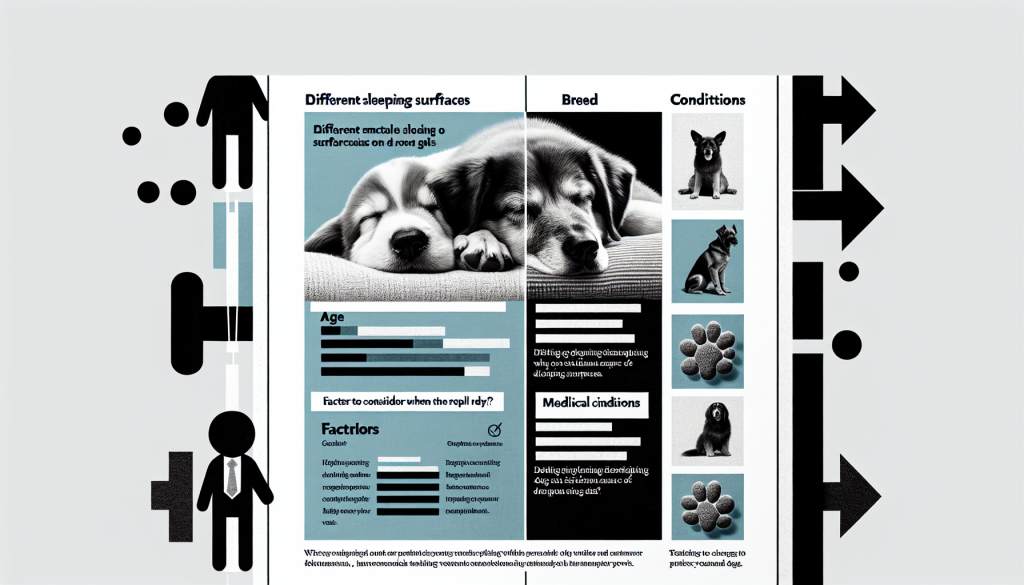Deciding whether dogs should sleep on hard or soft surfaces can be a perplexing question for many pet owners. While some believe that a firm, supportive bed is ideal for canine comfort, others argue that a plush, cushioned surface would ensure a peaceful slumber for their furry friends. In this article, we will explore the advantages and disadvantages of both options, shedding light on the age-old dilemma of where our beloved canines should lay their weary heads at night. From the potential impact on joint health to the importance of temperature regulation, we will navigate through the factors that should be considered when choosing the perfect sleeping surface for your four-legged companion.

Importance of Proper Sleep for Dogs
The role of sleep in a dog’s overall health
Proper sleep is crucial for a dog’s overall health and well-being. Just like humans, dogs need sufficient quality sleep to recharge and rejuvenate their bodies. During sleep, their bodies undergo essential processes such as rejuvenating cells, restoring energy levels, and strengthening the immune system. Without adequate sleep, dogs may experience various health issues, including weakened immune systems, decreased cognitive function, and an increased risk of obesity.
How sleep affects a dog’s behavior and mood
Sleep plays a significant role in regulating a dog’s behavior and mood. Sufficient sleep helps dogs maintain a balanced and positive temperament, making them less prone to aggression or irritability. When dogs lack proper sleep, they may become restless, anxious, or display behavioral problems. Additionally, insufficient sleep can affect their ability to concentrate and learn, hindering training and socialization efforts.
Common sleep problems in dogs
Just like humans, dogs can experience sleep problems. Some common sleep issues include difficulty falling asleep, frequent waking during the night, and excessive daytime sleepiness. These sleep problems can be caused by various factors such as discomfort, underlying health conditions, anxiety, or environmental disturbances. It is essential for dog owners to identify and address these sleep problems to ensure their furry companions get the quality rest they need.
The Effect of Sleeping Surface on Dog’s Health
Impact of hard surfaces on a dog’s body
Sleeping on a hard surface can have negative effects on a dog’s body. The unforgiving nature of hard surfaces, such as concrete or tile floors, can lead to increased pressure on their joints and bones. This can result in discomfort, pain, and even the development of orthopedic issues over time. Hard surfaces do not provide adequate support for a dog’s body, which can lead to improper spinal alignment and musculoskeletal strain.
Benefits of sleeping on soft surfaces for dogs
Providing dogs with soft sleeping surfaces can have numerous benefits for their health. Soft surfaces, such as orthopedic beds or memory foam mattresses, offer cushioning and support for a dog’s body. They help distribute the weight evenly and relieve pressure on sensitive joints and bones, reducing the risk of developing orthopedic issues. Soft surfaces also promote better circulation, ensuring that blood flows freely through their body while they sleep.
Possible orthopedic issues caused by hard surfaces
Sleeping on hard surfaces can contribute to the development of orthopedic issues in dogs. Frequently resting on hard surfaces without adequate cushioning can accelerate wear and tear on their joints, leading to conditions such as arthritis or hip dysplasia. These conditions can cause chronic pain, decreased mobility, and a reduced quality of life for dogs. Providing a comfortable and supportive sleeping surface can help prevent or manage these orthopedic issues.
Pressure points and their relation to sleeping surfaces
Pressure points are areas on a dog’s body where the weight concentrates when they lie down. Sleeping on a hard surface can increase the pressure on these points, leading to discomfort and potential development of pressure sores. Soft surfaces, on the other hand, help distribute the weight more evenly, reducing pressure on specific areas. This can provide dogs with a more comfortable and pain-free sleep experience.
Considerations for Choosing the Right Sleeping Surface
Understanding individual dog’s needs
When choosing a sleeping surface for your dog, it is crucial to understand their individual needs. Consider factors such as their age, size, breed, and any existing health conditions. Some dogs may require extra support for their joints, while others may prefer a cooler surface. By taking into account your dog’s specific needs, you can ensure that they have a sleeping surface that promotes their overall health and comfort.
Breed, size, and age factors in selecting a sleeping surface
Different breeds, sizes, and ages of dogs have varying needs when it comes to sleeping surfaces. Large breed dogs may require larger beds with thicker padding to accommodate their size and weight. Small breed dogs may benefit from softer surfaces that provide extra warmth and coziness. Older dogs may require orthopedic beds that offer joint support and pressure relief. Tailoring the sleeping surface to your dog’s breed, size, and age will help optimize their comfort and well-being.
Preference and comfort of the dog
Ultimately, your dog’s preference and comfort should be a significant determining factor in selecting a sleeping surface. Observe how your dog sleeps and pay attention to their preferences. Some dogs may prefer a firm surface, while others enjoy the plushness of a soft bed. By considering your dog’s personal preferences, you can ensure that they have a sleeping surface that they genuinely enjoy and feel relaxed on.
Temperature regulation and insulation
Temperature regulation is an essential consideration when choosing a sleeping surface for your dog. Some dogs may be more sensitive to heat and require a cooling surface, such as a raised bed or one made with breathable materials. Others may need a warmer surface, especially during colder months. Consider the climate and your dog’s temperature regulation needs to provide them with a sleeping surface that keeps them comfortable year-round.
Allergies and hygiene
If your dog has allergies or sensitivities, it is crucial to choose a sleeping surface that is hypoallergenic. Look for materials that are resistant to dust mites, mold, and other allergens. Additionally, consider the ease of cleaning and maintaining the sleeping surface for optimal hygiene. Removable and washable covers can help keep the sleeping surface clean and free from allergens, ensuring your dog’s health and well-being.
The Pros and Cons of Hard Surfaces for Dogs
Advantages of hard surfaces for dogs
While hard surfaces may not be ideal for prolonged periods of sleep, they do offer some advantages for dogs. Hard surfaces, such as cool tiles or concrete floors, can provide a reprieve from heat during warmer months. These surfaces can be beneficial for dogs who easily overheat or those with thicker coats. Additionally, some dogs may simply prefer the firmness of a hard surface for short periods of rest.
Disadvantages and potential drawbacks of hard surfaces
Despite their advantages, hard surfaces can pose risks and potential drawbacks for dogs. Prolonged exposure to hard surfaces can lead to pressure sores, joint pain, and musculoskeletal issues. Dogs who regularly sleep on hard surfaces may experience discomfort and pain, especially as they age. It is important to strike a balance and provide dogs with a mix of soft and hard surfaces to accommodate their needs and reduce the potential negative effects of hard surfaces.

The Pros and Cons of Soft Surfaces for Dogs
Advantages of soft surfaces for dogs
Soft surfaces offer numerous advantages for dogs, especially when it comes to their comfort and health. These surfaces provide cushioning and support, reducing the risk of pressure sores and joint pain. They promote better circulation, allowing dogs to fully rest and recharge their bodies. Soft surfaces also create a cozy environment that dogs find comforting, helping to alleviate anxiety and promote better sleep quality.
Disadvantages and potential drawbacks of soft surfaces
While soft surfaces are generally beneficial for dogs, there are a few potential drawbacks to consider. Dogs that shed heavily may find soft surfaces more challenging to clean and maintain. Some soft surfaces may also retain heat, which can be uncomfortable for dogs who are sensitive to warmer temperatures. It is important to choose soft surfaces that are easy to clean and regulate temperature to ensure your dog’s comfort and hygiene.
Dogs with Specific Medical or Physical Conditions
Arthritis and joint problems
For dogs with arthritis or joint problems, choosing the right sleeping surface is vital. Orthopedic beds or mattresses with memory foam can provide the necessary support and cushioning to alleviate joint pain and promote better sleep. These surfaces contour to the dog’s body, relieving pressure on their joints and helping them maintain proper spinal alignment.
Injury recovery and rehabilitation
Dogs recovering from injuries or undergoing rehabilitation may require specialized sleeping surfaces. Consult with your veterinarian or a canine rehabilitation specialist to determine the best surface for your dog’s specific needs. In some cases, inflatable or orthopedic beds may be recommended to provide maximum support and aid in the recovery process.
Hip dysplasia and other musculoskeletal issues
Hip dysplasia and other musculoskeletal issues can cause chronic pain and discomfort for dogs. Soft surfaces that offer ample support and cushioning can help alleviate the symptoms associated with these conditions. Orthopedic beds or mattresses designed specifically for dogs with hip dysplasia can provide the necessary relief and promote better mobility.
Senior dogs and comfort considerations
As dogs age, they may experience age-related conditions such as arthritis, muscle weakness, or cognitive decline. Providing them with a soft and supportive sleeping surface can help alleviate discomfort and promote better sleep quality. Consider orthopedic beds with memory foam or other specialized options designed for senior dogs to ensure their comfort and well-being.
Pregnant or nursing dogs
Pregnant or nursing dogs require extra comfort and support during sleep. Soft surfaces, preferably with bolstered sides or nesting features, can provide the security and relaxation they need. These surfaces allow pregnant or nursing dogs to comfortably rest and support their bodies as they go through these critical stages of their lives.
Training and Behavior Implications
House training and sleeping surfaces
The choice of a sleeping surface can have training implications, especially during the house training process. Dogs naturally avoid soiling their sleeping area, so providing them with a smaller, enclosed space, such as a crate or a bed with raised edges, can help with house training. This teaches them to associate their sleeping area with rest and cleanliness, promoting better bathroom habits.
Crate training and sleeping surface preferences
Many dog owners utilize crates as a training tool, and the choice of a sleeping surface inside the crate is crucial. Soft surfaces, such as comfortable bedding or mats, can make the crate a cozy and inviting space for dogs. This helps with crate training, as dogs are more likely to view their crate as a positive and safe sleeping environment.
Separation anxiety and comfort during sleep
For dogs with separation anxiety, a comfortable sleeping surface can provide a sense of security and comfort during sleep. Soft surfaces, combined with other calming measures such as soothing music or aromatherapy, can help dogs relax and sleep better, reducing anxiety-related behaviors during periods of separation from their owners.
Providing Comfort and Support for Dogs
Orthopedic beds and mattresses
Orthopedic beds and mattresses are specifically designed to provide maximum support and comfort for dogs. These beds feature memory foam or other specialized materials that contour to the dog’s body, relieving pressure on their joints and promoting proper spinal alignment. Orthopedic beds are an excellent choice for dogs with orthopedic issues, older dogs, or those requiring extra support for their joints.
Memory foam options for dogs
Memory foam surfaces offer excellent cushioning and support for dogs’ bodies. These surfaces conform to the dog’s shape, providing pressure relief and optimal comfort. Memory foam beds or mattresses are ideal for dogs suffering from arthritis, joint pain, or other musculoskeletal issues. They absorb movement, reducing the likelihood of disturbed sleep for both the dog and their owners.
Elevated or raised beds
Elevated or raised beds have gained popularity for their unique benefits. These beds feature a suspended platform that keeps dogs off the ground, providing ventilation and temperature regulation. Elevated beds can be particularly useful in warmer climates, as they allow air to flow underneath, keeping dogs cool. They also help reduce the risk of pressure sores and provide dogs with a comfortable and supportive sleeping surface.
Additional accessories for enhanced comfort
In addition to selecting the right sleeping surface, there are various accessories available to enhance dogs’ comfort during sleep. Bolster pillows or side cushions can create a cozy nesting environment, providing dogs with a sense of security. Blankets or heating pads can offer additional warmth during colder months. It is important to introduce these accessories gradually and ensure they do not pose any potential hazards.
Creating a cozy sleep environment
Creating a cozy sleep environment for your dog involves more than just choosing the right sleeping surface. Consider factors such as lighting, noise levels, and temperature in the sleeping area. Providing a quiet and dimly lit space can help promote better sleep quality. Maintaining a comfortable temperature that is not too hot or cold ensures that your dog can rest peacefully throughout the night.
Common Myths and Misconceptions
Hard surfaces are always better for dogs’ posture
Contrary to popular belief, hard surfaces are not always better for dogs’ posture. While dogs need some level of firm support, prolonged exposure to hard surfaces can lead to orthopedic issues and joint pain. Providing a balance between firmness and cushioning is essential for promoting a dog’s musculoskeletal health and overall well-being.
Soft surfaces cause laziness or behavioral issues
There is a common misconception that sleeping on soft surfaces can lead to laziness or behavioral issues in dogs. However, this is unfounded. Soft surfaces promote better sleep quality, which is crucial for a dog’s physical and mental health. Well-rested dogs are more likely to be active, engaged, and display positive behavior.
One size fits all – finding the right balance
There is no one-size-fits-all solution when it comes to choosing the right sleeping surface for dogs. Each dog has unique needs and preferences. It is essential to find the right balance between firmness and cushioning that caters to your dog’s individual requirements. Observing your dog’s behavior, consulting with your veterinarian, and being open to trying different sleeping surfaces can ensure that you find the perfect fit.
Conclusion
Providing your dog with a proper sleeping surface is essential for their overall health, comfort, and well-being. Sleep plays a vital role in a dog’s physical and mental health, as well as their behavior and mood. Understanding the impact of different sleeping surfaces on a dog’s body allows us to make informed decisions that optimize their sleep quality and support their musculoskeletal health. By considering factors such as individual needs, breed, size, age, and personal preferences, we can ensure that our furry companions have a cozy and supportive sleep environment. Remember, striking a balance between soft and hard surfaces, observing your dog’s preferences, and adapting to their health requirements are key to providing them with the best sleeping experience possible.
